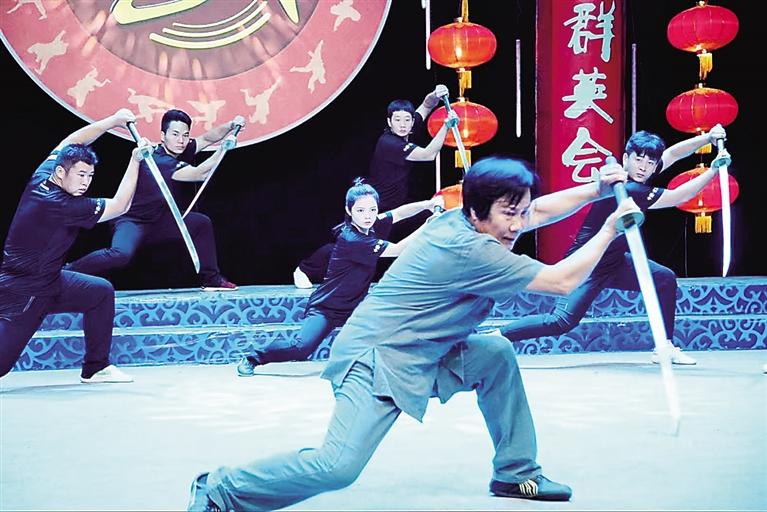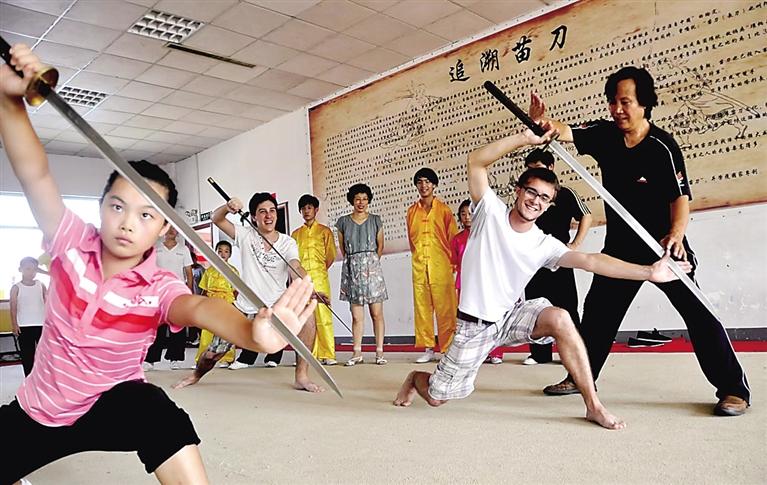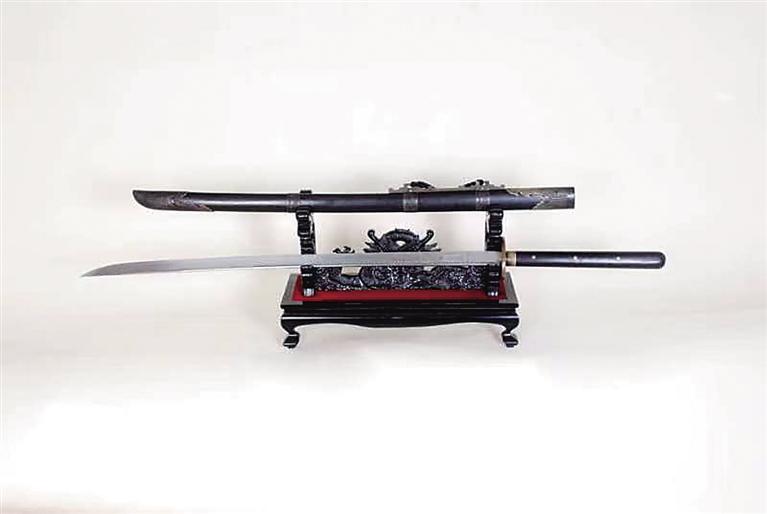The inheritance of martial arts includes the inheritance of equipment production. The unique Miao knife in Cangzhou martial arts equipment, through the efforts of Guo Ruixiang and Guo Tieliang father and son, not only restored the long-lost forging process, but also the gorgeous pattern, sharp edge, good elasticity and beautiful exterior, perfectly combined with the Miao knife knife technique, achieved a historic breakthrough –
Forging knives, tempered by a thousand times, passed down "Four Absolutes"
Our reporter, Qi Lingxiao



Chinese seedling knife and its teaching and inheritance
Knife King
Recreate the power of cold weapons
One day in 2011, Wei Hongzhong, a martial artist who had assisted in filming the special program Miao Dao, packed up his equipment and got on his motorcycle to finish work and go home. At this time, the motorcycle had started to drive, and suddenly, a person with a long gun stabbed him from behind. Listening to the sound, turning around, and tilting, the three movements were completed almost simultaneously. In the blink of an eye, the hard ash gun rod was cut off by the brush, and the gun head and gun were dropped to the ground.
This was not a pose-up. Without advance notice or preparation, the sudden attacker just wanted to sneak attack and let the CCTV "I Love Invention" program team see the power of Cangzhou martial arts, especially Miao Dao.
This scene was recorded with a mobile phone, and it was exciting to watch. White wax rods are extremely hard and generally cannot be cut off, not to mention sudden attacks. The results of the surprise attack and dynamic block made the program team feel more and more magical about this long knife.
That day, the program team was filming a special topic of "Sword King Hegemony" in a park in Cangzhou. The first shooting started from static. 200 sheets of rice paper were tied to the tree, and Guo Tieliang, the direct grandson of Guo Yanzi (Changsheng), was wearing a short rest close to his body, and he stabbed straight with a knife. Penetrating. Replace it with 800 sheets of rice paper, 10 cm thick, can it still be pierced? The crew members questioned. Turning around, the knife is piercing through the back of the paper. Guo Tieliang, who has been practicing knives for 10 years, can pierce, but can a 9-year-old girl do it? The child himself and the watching Cangzhou martial artists have no confidence in this either. Then try it. Penetrating again. Although not as strong as Guo Tieliang, the tip of the knife still pierced through the thick rice paper. If it could pierce through thick paper, could the vines that even crossbows could not pierce be destroyed by a seedling knife? After field tests, the vines could not withstand each strike.
Flirting, chopping, chipping, and stabbing are the four major uses of the seedling knife. What would it be like if the 4 actions were done in a row? The program team wanted to continue to open their eyes and erected 4 more wooden piles, and 4 watermelons were installed on the piles. The series of actions was demonstrated by Guo Ruixiang’s disciple Wang Guochun. Wang Guochun entered the circle with a knife in one go, accurate and fast. The 3 watermelons presented a perfect cut, and the last watermelon was penetrated by the tip of the knife.
This time, the program team was content and no longer asked for anything new. But when they saw Guo Tieliang and others erecting a row of wooden piles on the roadside, allowing people to push bicycles and motorcycles, the program team was bored. What was this for?
It turned out that Guo Tieliang had his own plans. Since he wanted to show the power of the Miao Knife to the whole country or the world through CCTV, he would show it thoroughly. The martial artist Zhang Liqiang rode a bicycle and slashed on a motorcycle. The Miao Knife is very long and heavy. It requires two hands, one hand to hold the bicycle handle, and the other hand to wield the knife. It is necessary to master the balance of the bicycle and have the aim. It is very difficult to complete four consecutive movements at once. Motorcycle drivers have to cooperate with the knife hand, but also avoid the driver’s body to wield the knife, simulating ancient combat immediately, which is more difficult. In this way, it is a restoration of the use of the Miao Knife in the cold weapon era.
The result was perfect. The program team used the word "good" and "didn’t expect" to express their surprise to the world. In fact, what surprised them even more was the broken gun in Wei Hong’s attack, which the program team couldn’t find the right language to express.
Sanxia Zhejiang
Development of Chinese seedling knife
Miao Dao can be said to be the unique sword and stunt of modern Cangzhou martial arts. At the beginning of the last century, when the young Cangzhou martial artist Guo Yanzi toured the martial arts camp of Cao Kun in Zhili, he was "secretly taught" by Liu Yuchun, the head teacher of Tianjin Duliu, and Liu Yuchun’s Miao Dao was obtained by changing skills with the Xie brothers of Dongguang Sangyuan in Cangzhou, and then spread to the northeast earlier. Regarding the knife technique, an earlier literature can be found in the "Selection of Single Sword Techniques" in Cheng Chong’s "Forging Remaining Techniques" in the Ming Dynasty. Although the knife technique inherits the grass, snake and gray line, there are traces to follow, but the forging method of Miao Dao is a historical secret and has been lost for a long time. After Guo Yanzi was "secretly taught" by Liu Yuchun, the technique of Miao Dao was passed back to Cangzhou, but the forging method was not passed down.
Guo Yanzi’s son, Guo Ruixiang, is one of the top ten martial arts teachers in the country and one of the inheritors of the seedling knife technique. There is a seedling knife left by Guo Yanzi at home. The knife was forged by Cao Kun, the famous Zhejiang Longquan "Shen Guanglong", and Guo Ruixiang donated it to the country a few years ago. The knife became a sample for Guo Ruixiang and Guo Tieliang’s father and son to develop a seedling knife forging method.
"Before my grandfather died, he instructed me to pass on the Miao knife," Guo Tieliang said. "Not only to pass on the knife technique, but also to explore the forging method of the Miao knife. My father kept my grandfather’s instructions in mind and began to explore the re-forging of the Miao knife around the beginning of this century."
The history of swordsmithing in Cangzhou is also very long, and it should be able to forge seedlings. With this idea in mind, Guo Ruixiang and his son Guo Tieliang started a journey to forge seedlings again. They found out that there was an old master who could forge swords in the western countryside of Cangzhou and visited on a bicycle. After explaining the purpose of the visit and the characteristics of the seedlings, the old master shook his head and refused – this kind of knife has strict requirements on material, size and forging method, and ordinary craftsmen cannot do it. The two men did not give up and went to Dulin in Cangxian County to ask another old master to forge. The old master gave the same conclusion: it cannot be forged.
"My father was not discouraged. After bumping into the wall several times, he suddenly thought, since the Miao knife hidden at home was made by the Zhejiang’Shen Guanglong ‘, can it be forged in the south?" With a glimmer of hope, the two men rushed to Zhejiang. The reply from the Zhejiang swordsmith was heartening: it can be forged, and it can be forged using the ancient method. Then it was time to wait for good news. However, a few months later, after getting the first newly forged knife, Guo Ruixiang was disappointed. Because forging is one thing, but it is another – the center of gravity of the newly forged seedling knife deviates from the requirements of martial arts, making it awkward. After the two returned, they carefully analyzed the data of the Miao knife passed on by Guo Yanzi, drew the new discovery of the center of gravity of the knife into an accurate pattern and sent it to the sword master again. The second forging was successful, and it was easy to use. So, how is the toughness and hardness of the new knife? After testing, the toughness and hardness of the new Miao knife are not ideal. It is too hard and will break when it touches heavy weapons. It is too soft, not tall and straight enough, and the power of the thorn is greatly reduced.
The two of them simply ate and lived together with the sword forging master and studied day and night. From the proportion of steel and carbon used in the Jiazang Miao Knife, the experiment of the quenching time and the quenching method, the length, weight, and shape of the knife, a comprehensive and thorough study. The third forging knife was really successful.
The new miaodao absorbs the advantages of the old miaodao, and combines it with actual combat to make more subtle improvements. The biggest improvement is the blade spine. "The blade spine of the miaodao left by grandpa is square, but my father changed the blade spine into a circle based on the requirements of martial arts confrontation and the characteristics of ancient swords," Guo Tieliang said. The so-called circle is actually the "loach back". The bottom foot of Chinese porcelain is mostly used in this shape to reduce the friction of the bottom foot and reduce the pressure. If the actual combat miaodao is changed to "loach back", it will not only help to block, but also reduce the weight of the blade body, making the blade body denser and stiffer, and the weight, flexibility, hardness and actual combat effect are better.
This is a new breakthrough after inheriting the ancient method of miaodao forging, and it is a great progress for Cangzhou martial artists to integrate martial arts into equipment production. After several confrontation experiments, this improvement is proved to be scientific. On November 7, 2001, a memorable day in the history of Cangzhou martial arts – the State Intellectual Property Office awarded Guo Ruixiang a utility model patent certificate, patent name: Miaodao.
trace back to the source
Cangzhou seedling knife fire inheritance
Miao Dao, which has flourished in Cangzhou for nearly a hundred years, looks a bit like Japanese swords, but it is actually the ancestor of Japanese swords. Its history can be traced back to the Han and Tang Dynasties, and Guo Yanzi in Cangzhou is unique in his skills. Through the efforts of Guo Ruixiang, Guo Tieliang and his son, the long-lost Miao Dao forging technology was restored. In view of the outstanding performance of martial arts and Miao Dao in resisting the Wushu and insults in successive dynasties, Guo Ruixiang named the newly developed Miao Dao "Chinese Miao Dao Wushu Soul".
Before the development of the Miao knife, Guo Ruixiang, Guo Tieliang and his son made a deep excavation of the history of the Miao knife. The Miao knife in history has power, law and no name. Liu Tao, a famous general and a native of Cangzhou, led his soldiers to fight against the Japanese on the southeast coast for more than ten years, and used Qi Jiguang in an unusual way. According to the fighting habits of the Japanese pirates, Qi Jiguang changed the single knife used by the soldiers to a long knife, and passed the usage to the soldiers. They slashed the banner of the General Qing and dealt heavy losses to the Japanese pirates. After that, the records of Cheng Chongdou’s "Single Saber Dharma Selection" in the late Ming Dynasty made this treasure passed down, "using the power, the image, and the name". Later generations named it because of its slender blade body like a seedling.
Guo Tieliang said that the data show that the embryonic form of the Miao knife can be traced back to the "ring hand knife" at the end of the Eastern Han Dynasty and the "long knife" during the Cao Wei period of the Three Kingdoms. The "long knife" developed to the Sui and Tang Dynasties, and has become an incomparably sharp actual combat blade "Tang knife". Archaeological excavations show that the "ring hand knife" in the Han Dynasty was found in ancient tombs, and the shape of the knife is very similar to that of the modern Miao knife. According to this, it is inferred that the embryonic form of the Miao knife has existed as early as the Han Dynasty in our country.
Yang Hong, a historian at the Chinese Academy of Social Sciences, also argued in his book "On the Cluster of Ancient Chinese Weapons" that "a strange knife is also a long knife." Guo Ruixiang’s "Textual Research on the Miao Knife", which is collected by the Chinese Historical Archives, wrote: "The Miao Knife was used to charge, far superior to a single sword and other short soldiers." In all previous anti-Japanese wars, he had excellent performance.
The newly developed seedling knife is known as the "Four Absolutes". The seedling knife forged with high-grade patterned steel has strict requirements in production.
Guo Tieliang pulled out a high-grade seedling knife to demonstrate that choosing the right raw materials is a prerequisite, one is wool iron, and the other is steel. The so-called wool iron is actually a local method of smelting iron with low iron content and carbon content and more impurities, but it is soft and viscous, and is suitable for repeated folding and forging. The so-called "three catties of wool iron and half a catty of steel" can withstand a thousand trials. The appropriate amount of carbon in "wool iron" and "steel" can get fresh and eye-catching patterns.
After the material is selected, it is forged. First, the wool iron is "exercised". After repeated forging, the blank is decarbonized, and impurities are removed to make the blank more pure. This is decarbonization steelmaking. The second is forming forging. During the process, metal molecules are organically combined with activated carbon, the density of the knife body is increased, and a knife strip with extremely high hardness and toughness is made. This is also known as the carburizing process. After forging the knife strip, it is quenched. The formed knife strip is burned in the furnace to a certain temperature and then quickly cooled back. The method, time and medium not only affect the flexibility and sharpness of the knife, but also affect the brightness of the pattern. The commonly used medium for quenching is water, oil and special liquid, etc. Different steels have different media, so that various steel seedlings can obtain different hardness. After quenching, it is tempered. The purpose is to reduce the unreasonable hardness after quenching. After the knife is tempered in a furnace at 250-300 degrees Celsius for 6-8 hours, the molecular structure of the metal changes and the knife body obtains the best quality.
The final process is grinding and decoration.
At this stage, the grinding stone is very important, and the grinding stone is also called the bright stone. Different grinding stones have different functions. After orderly grinding, the knife body can reach the level of no pitting and smooth as a mirror. Grinding is very time-consuming, and the ancients said "sharpening a sword in ten years", which fully illustrates the importance and time spent on grinding the seedling knife. The seedling knife uses red sandalwood as the handle sheath and bronze as the carving. The blade and the scabbard are slightly tight and not loose, and the loosening is appropriate, so that the thrusting of the knife is just right. After these processes, a complete new type of seedling knife is considered complete.
Exceptionally sharp, brilliant literary talent, comfortable and flexible, and difficult to rust and corrode are the four characteristics of seedling knives. As far as the hundred-refined pattern steel seedling knives are concerned, the gorgeous pattern, sharp edge, good elasticity and beautiful exterior constitute the "four absolute" of modern high-end seedling knives.
The Chinese Miaodao technique is superb in Guo Yanzi and interprets the legend of Cangzhou martial arts; the forging of the Chinese Miaodao, in the hands of Guo Ruixiang and his son, has been tempered for thousands of times, presenting the inheritance of academic research and equipment research and development.